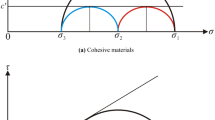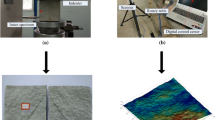Conclusions
The authors suggest physical equations for the relation between the stresses and deformation strains (1.8).
They test the resulting relations (1.8) using experimental data for various rocks. The experimental results agree with the analysis (Figs. 1–3).
For a horizontal working, using physical relations (1.8) they formulate the plane problem of the theory of creep (of mathematical physics). Their scheme of calculation is governed by technological requirements: A constant or time-dependent active pressure which models the operation of yielding supports acts on the periphery of the working; the boundary conditions also vary with time, simulating the influence of extraction operations.
The authors derive equations for the optimum support parameters, the convergence of the working (3.12), and the reaction of the supports (3.12).
They test these results under pit conditions. The theoretical data agree with the results (Fig. 5).
Similar content being viewed by others
Literature Cited
P. A. Rebinder, “The structural-mechanical properties of rocks,” in: Problems of Tectonic Physics [in Russian], Gosgeoltekhizdat, Moscow (1960).
A. A. Repko, “On changes in the volume of argillaceous rocks and equivalent materials due to creep under uniaxial compression”, in: Problems in the Rheology of Rocks [in Russian], Naukova Dumka, Kiev (1970).
E. P. Shusherina, “The coefficient of lateral deformation and the bulk deformation of frozen soils during the creep process,” in: Permafrost Research [in Russian], No. 5, Izdvo MGU, Moscow (1966).
Zh. S. Erzhanov, A. S. Saginov, and Yu. A. Vekler, Calculation of the Stability of Mine Workings Subjected to Large Deformations [in Russian], Nauka, Alma-Ata (1973).
S. R. Meschyan, “On the long-term resistance of clay soils to shear,” Izv. Akad. Nauk ArmSSR,15, No. 2, (1962).
M. V. Gzovskii, Fundamental Aspects of the Tectonic Physics and Tectonics of the Baidzhanosai Anticlinorium [in Russian], Parts 3 and 4, Izd-vo AN SSSR, Moscow (1963).
G. I. Gurevich, “On generalization of Maxwell's equations to the case of three measurements with small deformations due to elastic aftereffect,” Trudy IFZ AN SSSR, No. 2 (1969), Izd-vo AN SSSR, Moscow (1959).
N. Ya. Denisov, The Nature of the Deformation Strength of Soils [in Russian], Stroiizdat, Moscow (1972).
A. A. Vorob'ev, M. P. Tonkonogov, and Yu. A. Veksler, Theoretical Aspects in the Physics of Rocks [in Russian], Nedra, Moscow (1972).
N. K. Pekarskaya and V. S. Sheveleva, “A study of the structure of soil during the process of torsional creep.”, in “Permaforst Research, Questions of Construction [in Russian], No. 4, Syktyvkar, (1973).
A. N. Stavrogin, “On the limiting states and deformation of rocks”, Trudy VNIMI, Leningrad (1965).
A. S. Stroganov, “Methods of combined calculation for mine supports and rock pressure in rocks with nonlinear-elasticoviscous properties,” in: Rock Pressure and Supports of Vertical Shafts [in Russian], Gosgortekhizdat, Moscow (1963).
M. Ya. Leonov and S. V. Gavrilenkov, “Features of the deformation of semibrittle bodies,” Izv. Akad. Nauk KirgSSR, No. 1 (1966).
M. Ya. Leonov, K. N. Rusinko, and S. A. Abdrakhmanov, “Analytical investigation of deformation of semibrittle bodies,” Izv. Akad. Nauk KirgSSR, No. 3 (1966).
M. Ya. Leonov and K. N. Rusinko, “On the mechanism of deformation of a semibrittle body,” in: Plasticity and Brittleness [in Russian], Ilim, Frunze (1967).
M. Ya. Leonov, V. A. Panyaev, and K. N. Rusinko, “The relation between deformation and stresses for semibrittle bodies,” MTT, No. 6 (1967).
M. Ya. Leonov, K. N. Rusinko, and M. B. Chormonov, “On the influence of disintegration on a material on the distribution of stresses”, in: Stress Concentration [in Russian], No. 2, Naukova Dumka, Kiev (1968).
V. I. Kuneev and K. N. Rusinko, “Orthogonal loading of materials with different tensile and compressive strengths,” MTT, No. 5 (1971).
S. S. Vyalov, “Some problems in soil mechanics,” Osnovaniya, Fundamenty, i Mekhan. Gruntov, No. 2 (1970).
Additional information
Institute of Physics and Mechanics of Rocks, Academy of Sciences of the Kirgiz SSR, Frunze. Translated from Fiziko-Tekhnicheskie Problemy Razrabotki Poleznykh Iskopaemykh, No. 3, pp. 7–14, May–June, 1976.
Rights and permissions
About this article
Cite this article
Aitmatov, I.T., Beknazarov, T.S. A method of calculating the optimum support parameters for development workings. Soviet Mining Science 12, 238–244 (1976). https://doi.org/10.1007/BF02594865
Received:
Published:
Issue Date:
DOI: https://doi.org/10.1007/BF02594865




